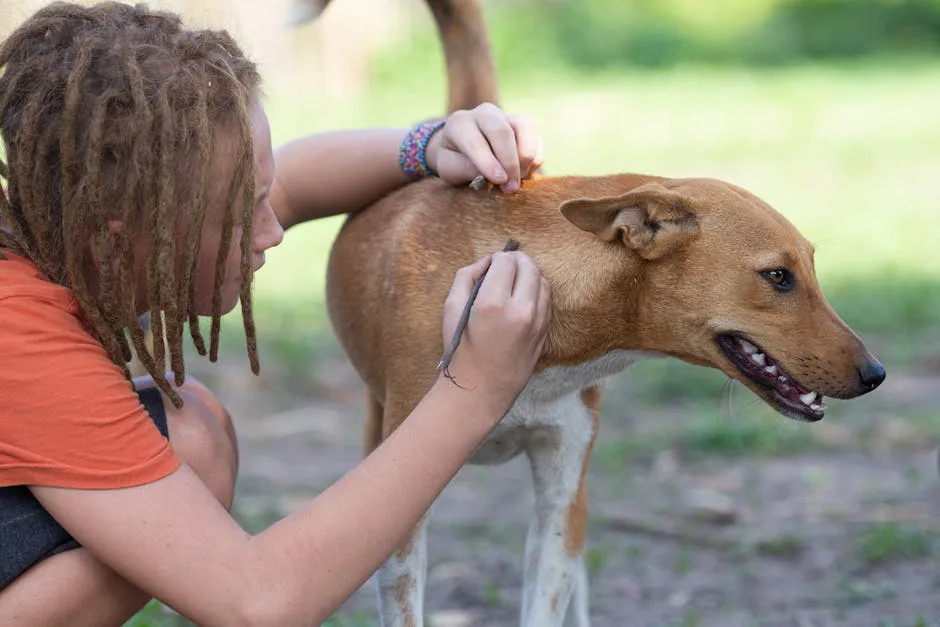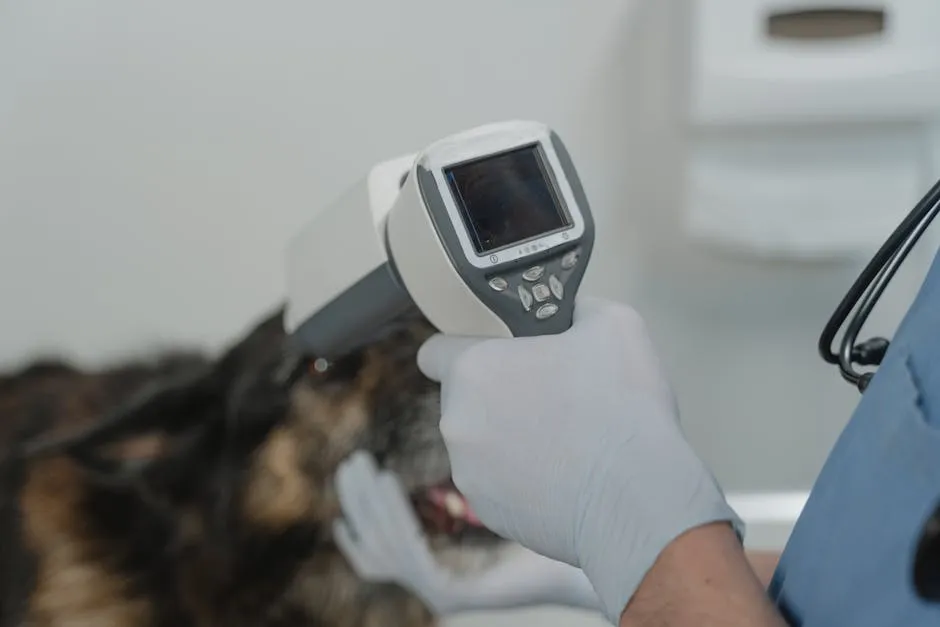Introduction
Lyme disease is a serious tick-borne illness that affects dogs. This disease can lead to severe health issues if not addressed. Pet owners must be aware of symptoms, treatment options, and prevention strategies. This article aims to provide essential information about Lyme disease in dogs.
Summary and Overview
Lyme disease is caused by the bacterium Borrelia burgdorferi. It primarily spreads through infected ticks, especially black-legged ticks. These ticks are often found in wooded or grassy areas. Recent statistics show that 1.4% to 13.3% of dogs in the U.S. test positive for this disease. The risk of infection is higher in certain regions, particularly the Northeast and Midwest.
Timely diagnosis and treatment are crucial. If left untreated, Lyme disease can lead to serious health complications, such as kidney failure and chronic joint pain. Early intervention can significantly improve your dog’s health and well-being. Speaking of intervention, having a Dog Health Monitoring Kit at home can help you keep an eye on your pet’s vital signs and detect any issues early!

Understanding Lyme Disease
What is Lyme Disease?
Lyme disease is an infection caused by the spirochete bacterium Borrelia burgdorferi. This bacterium can infect dogs when bitten by an infected tick. Once in the bloodstream, it can spread to various body parts, often affecting the joints or kidneys.
The disease is commonly found in the Northeastern, Upper Midwest, and Pacific Coast regions of the United States. Ticks thrive in these areas, especially in wooded and grassy environments. Co-infections with other tick-borne illnesses can also occur, complicating diagnosis and treatment.
Studies indicate that 5-10% of infected dogs develop clinical signs. Symptoms may not show up until 2-5 months after exposure, making regular check-ups essential. Consult your veterinarian for more information on Lyme disease and its implications for your dog’s health.

Transmission Mechanism
Lyme disease is transmitted mainly through the bite of black-legged ticks, also known as deer ticks. These ticks go through multiple life stages: larva, nymph, and adult. Each stage requires a blood meal to develop.
Transmission occurs when a tick is attached to a dog for at least 24-48 hours. Environmental factors, such as humidity and temperature, influence tick populations and activity levels.
Research shows that approximately 10-20% of black-legged ticks carry Borrelia burgdorferi. Awareness of tick habitats is vital for prevention. Regularly check your dog for ticks, especially after outdoor activities. If you find one, remove it promptly and consult your veterinarian for preventive measures. For those tick removals, consider using a Tick Removal Tool Kit to make the process easier and safer for your furry friend!

Symptoms of Lyme Disease in Dogs
Common Signs and Symptoms
Lyme disease can affect dogs in various ways. Many infected dogs show no signs at all. However, when symptoms do appear, they often include fever, lameness, and lethargy. You might notice your dog limping or having difficulty getting up.
Interestingly, symptoms may not surface until two to five months after infection. This delayed onset can make it challenging for pet owners to connect the dots. About 5-10% of infected dogs develop clinical symptoms, but the actual percentage can vary based on the individual dog’s health.
One serious complication of Lyme disease is Lyme nephritis, affecting the kidneys. This condition can lead to severe health issues like vomiting, weight loss, and increased thirst. If you observe any of these symptoms in your dog, it’s crucial to contact a veterinarian promptly. Additionally, a Dog Vaccination Records Book can help you keep track of your dog’s vaccinations and health history, ensuring timely interventions!

Diagnosis of Lyme Disease
How is Lyme Disease Diagnosed?
Diagnosing Lyme disease in dogs involves several steps. First, your veterinarian will conduct a thorough physical examination and discuss your dog’s medical history. This includes any recent tick exposure, which is vital for understanding the risk.
Blood tests play a significant role in diagnosing Lyme disease. One common test is the SNAP 4Dx test, which checks for antibodies against Borrelia burgdorferi. It’s important to note that antibodies may take four to six weeks to develop after a tick bite. Therefore, timing is crucial when testing for Lyme disease.
While a positive test indicates exposure to the bacterium, it doesn’t necessarily confirm active disease. Your vet may also recommend additional tests, such as urinalysis, to assess kidney health. If your dog shows symptoms or has a history of tick exposure, schedule a veterinary appointment for testing as soon as possible.

Treatment Options
How is Lyme Disease Treated?
Treating Lyme disease typically involves antibiotics. Doxycycline is the most commonly prescribed antibiotic, usually for a duration of 30 days. Amoxicillin is another option for dogs that may be sensitive to doxycycline. It’s essential to complete the entire course of antibiotics, even if your dog starts to feel better. You can also discuss the possibility of using Doxycycline Antibiotic for Dogs with your vet, as it can be effective in treating this condition.
In severe cases, such as those involving Lyme nephritis, additional supportive care may be necessary. This could include hospitalization and specialized treatments to manage kidney function. Most dogs respond well to antibiotic therapy, with symptoms often improving within a few days.
Success rates for treatment are generally high, especially with early intervention. However, some dogs may experience lingering effects, such as joint pain. Discuss all treatment options with your veterinarian to ensure the best care for your furry friend.

Prevention Strategies
How to Prevent Lyme Disease in Dogs
Keeping your dog safe from Lyme disease involves several proactive steps. First and foremost, using tick prevention products is essential. Options include topical treatments like Frontline Plus Flea and Tick Treatment and chewable tablets such as NexGard Chewables for Dogs. These products significantly reduce the chances of your dog encountering ticks.
Vaccination is another critical strategy. If you live in an area prone to Lyme disease, consult your veterinarian about vaccinating your dog. The Lyme vaccine requires two initial doses followed by annual boosters to maintain protection. Studies show that vaccination can lower the risk of infection significantly. For more information on vaccination, check out Understanding canine vaccinations and when they’re needed.
Vaccination against Lyme disease is crucial for dogs in high-risk areas. Understanding canine vaccinations and when they’re needed provides detailed insights on this topic.
Environmental management also plays a vital role in prevention. Regularly mow your lawn and keep brush trimmed to minimize tick habitats. Avoid letting your dog roam in tall grass or heavily wooded areas where ticks thrive. The Centers for Disease Control and Prevention indicates that effective prevention methods can reduce Lyme disease cases by up to 90%. Additionally, using a Dog Raincoat can keep your pooch dry during those wet adventures!
Always consult your veterinarian to determine the best prevention strategies tailored to your dog’s lifestyle and local risks.

Tick Removal and Management
Proper Tick Removal Techniques
Removing ticks promptly and correctly is essential for your dog’s health. First, ensure you have the right tools, such as fine-tipped tweezers or a specialized UV Light Tick Remover. Grasp the tick as close to your dog’s skin as possible, pulling straight out without twisting. This method reduces the chance of leaving mouthparts embedded in the skin.
Prompt removal is crucial because Lyme disease can be transmitted after the tick has been attached for 24-48 hours. After removal, clean the bite area with antiseptic and monitor your dog for symptoms like lethargy or swelling.
Regularly check your dog for ticks, especially after outdoor adventures. Studies indicate that timely tick removal can lower infection risk substantially. Educating yourself on proper tick checks and removal techniques can protect your furry friend from Lyme disease and other tick-borne illnesses. You might also consider investing in a Pet First Aid Kit for emergencies!
Conclusion
Lyme disease can significantly impact your dog’s health. This tick-borne illness may lead to severe complications if left untreated. Therefore, prevention is essential. Regularly check your dog for ticks, especially after outdoor adventures. Consult your veterinarian for advice on the best tick prevention methods.
As responsible pet owners, we must monitor our dogs closely for any signs of illness. If you notice unusual behavior, such as lethargy or limping, seek veterinary care immediately. Remember, proactive measures can help ensure your dog’s health and happiness. Stay informed and engaged in your dog’s health journey. And while you’re at it, a Dog Carrier Backpack can make traveling with your pup much easier!

FAQs
What happens if my dog tests positive for Lyme disease?
If your dog tests positive, your veterinarian will create a treatment plan. This usually involves a month-long course of antibiotics. In severe cases, hospitalization may be necessary for supportive care.
Is Lyme disease in dogs contagious to humans?
No, Lyme disease is not contagious between dogs or from dogs to humans. Humans can only contract the disease through bites from infected ticks.
How can I tell if my dog has Lyme disease?
Look for symptoms like fever, lameness, and lethargy. If you notice these signs, contact your veterinarian for a thorough examination and possible testing.
Which dogs are at higher risk for Lyme disease?
Dogs that spend time in wooded or grassy areas are at higher risk. Breeds with longer fur may also be more susceptible to tick exposure.
Can my dog be vaccinated against Lyme disease?
Yes, there is a vaccine for Lyme disease. Consult your veterinarian to determine if vaccination is appropriate for your dog based on its lifestyle and local risks.
Please let us know what you think about our content by leaving a comment down below!
Thank you for reading till here 🙂 And remember, a Dog Sweater for Winter can keep your pup cozy and stylish during the colder months!
All images from Pexels





